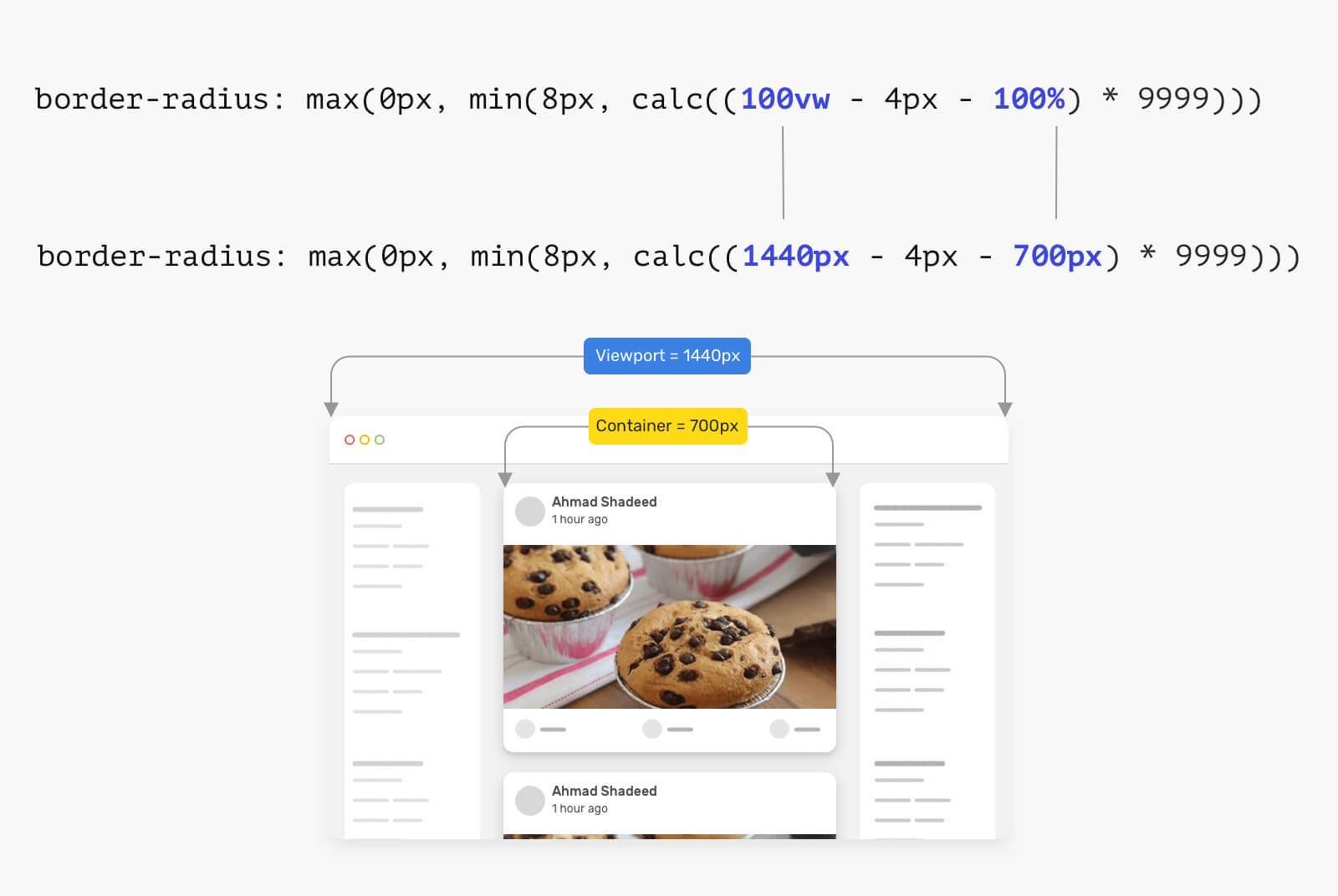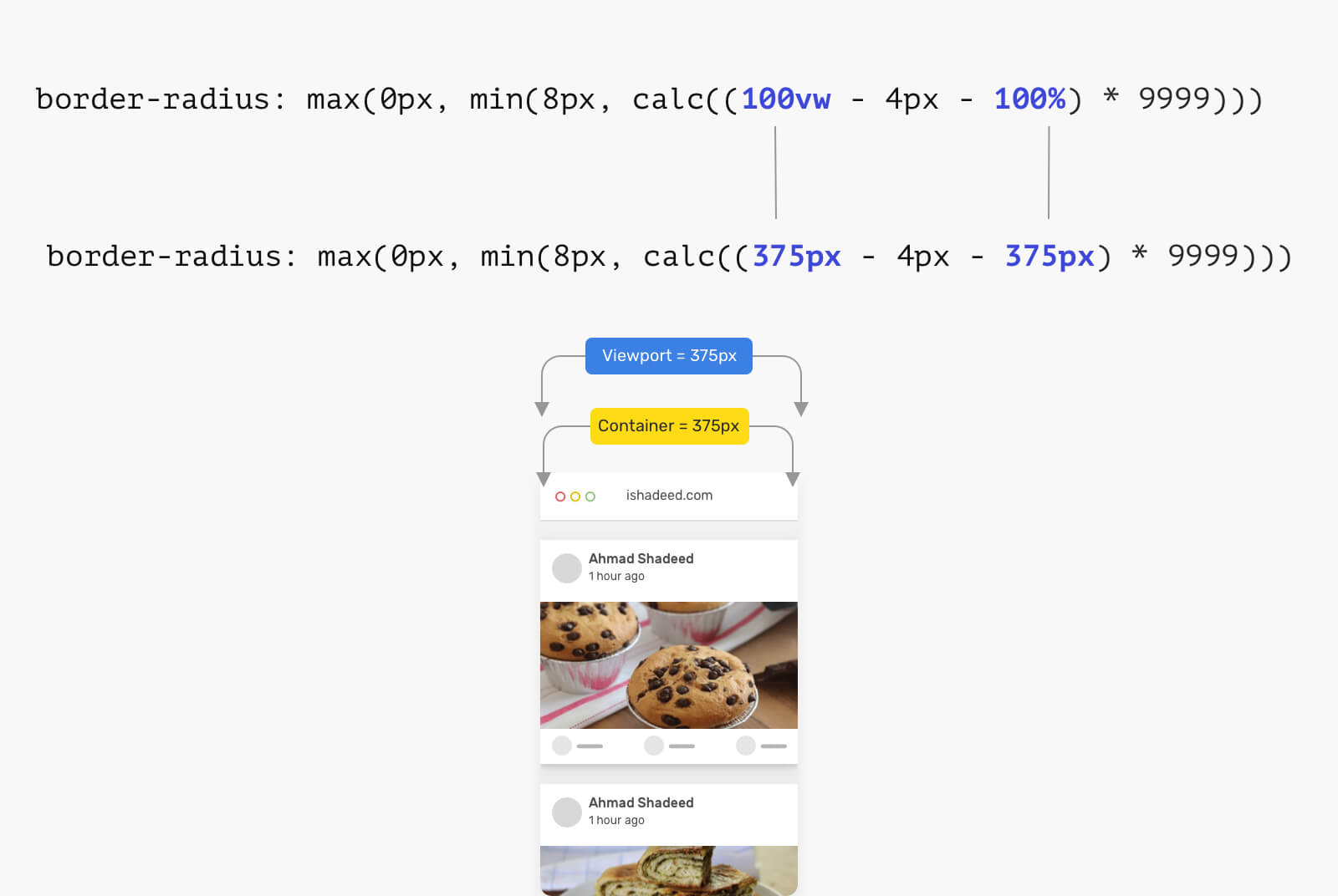

Conditional Border Radius In CSS
source link: https://ishadeed.com/article/conditional-border-radius/
Go to the source link to view the article. You can view the picture content, updated content and better typesetting reading experience. If the link is broken, please click the button below to view the snapshot at that time.

Conditional Border Radius In CSS
A while ago, I was inspecting facebook.com home page feed to learn and see how they build things out. I’m always curious to see how people write CSS. I noticed a very, very interesting border-radius value for the card component in the main feed.
I shared the following tweet about this little discovery. Then, I received this reply from Miriam Suzanne:
is it always 8px? That math looks like a toggle to me, where at a certain point ((100vw - 4px) - 100%) could be negative, toggling 9999 to -9999? Which would flip the value to 0? Basically: if we’re within 4px of the full viewport size, remove the border radius.
After a few hours, Frank Yan from Facebook (Yay!) confirmed that this is a conditional statement to flip 8px to 0px when the card is taking the full viewport width.
Isn’t that just amazing?
At first, I thought that this is a kind of bug or something that was done by mistake. Thankfully, I was wrong. In this article, I will try to highlight the problem, and explain how the solutions work.
The problem
We have a card component with a border-radius of 8px. When the card doesn’t have margin or is taking the full viewport width, we want to flip the border-radius to 0.

This can be done by removing the border-radius with a CSS media query like this.
@media (min-width: 700px) {
.card {
border-radius: 8px;
}
}
In some cases, that is limiting. If for some reason we want to activate the border-radius when the viewport size is less than 450px, we will need to create a variation CSS class and use media query again.
@media (max-width: 450px) {
.card--rounded {
border-radius: 8px;
}
}
The solution
This is a clever one that was done by the team Facebook. It mimics the following logic:
if (cardWidth >= viewportWidth) {
radius = 0;
} else {
radius = 8px;
}
To implement that logic in CSS, we need to compare between two values by using CSS comparison functions. If you don’t know them, I recommend reading this article by yours truly.
.card {
border-radius: max(0px, min(8px, calc((100vw - 4px - 100%) * 9999)));
}
Let’s walk through the above CSS in detail.
- We have a
max()function that compares between0pxand the computed value of themin(). It will pick the larger value. - The
min()function compares between8pxand a computed value fromcalc((100vw - 4px - 100%) * 9999). This will result with a very large positive or negative number.
Let’s explain the calc() magic!
The magic happens in the 100% value. It can be different based on two different scenarios:
- It can be equal to
100%of its containing element (The parent/wrapper.. or whatever it’s called in your CSS). - Or, it can be equal to the
100vw, in case the card is taking the full viewport width (E.g: in mobile).

Let’s take an example based on the first scenario (For the 100%). We have a viewport with a width of 1440px, and the card component lives within a 700px container.

Multiplying the resulted value by 9999 will result in 7359264, which is a large random number. In that case, the CSS will look like this for the browser:
.card {
border-radius: max(0px, min(8px, 7359264px));
}
Since we have min(), it will pick the smallest value which is 8px. When compared to the max(), the 8px will win too. That’s the first use-case of this clever CSS.
.card {
border-radius: 8px;
}
Next, is when the card is taking the full viewport width. That can be seen in a mobile viewport. Notice that the container and viewport width are the same.

Multiplying the value with 9999 will result in -39996px, which is a negative value. The browser will read it like the following:
.card {
border-radius: max(0px, min(8px, -39996px));
}
Now to the fun! The browser has two questions to ask:
- Which value is smaller?
8pxor-39996px? The result is-39996px. - Which value is larger?
0pxor-39996px? The result is0px.
.card {
border-radius: 0px;
}
Did you see how that happened? I’m still surprised by such a clever usage of CSS comparison functions.
We can also take this to the next level by using CSS clamp() as suggested by Temani Afif and Liad Yosef. I think team Facebook didn’t use it since it’s not supported in older versions of Safari (e.g: v12).
.card {
border-radius: clamp(0px, ((100vw - 4px) - 100%) * 9999, 8px);
}
Check it out on Codepen.
I hope you enjoyed the article. Thanks for reading!
Recommend
About Joyk
Aggregate valuable and interesting links.
Joyk means Joy of geeK